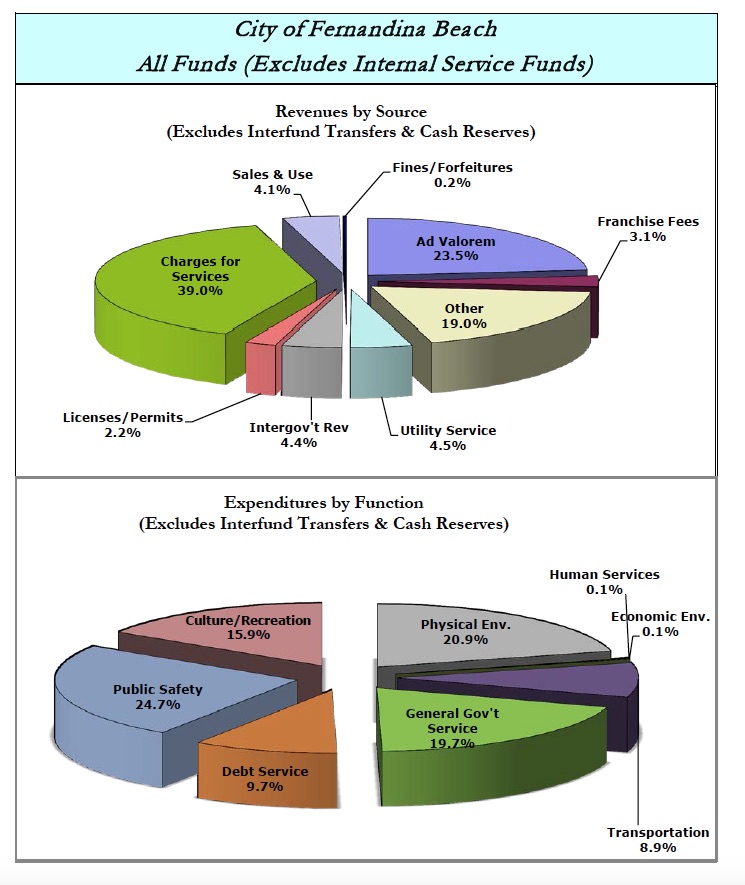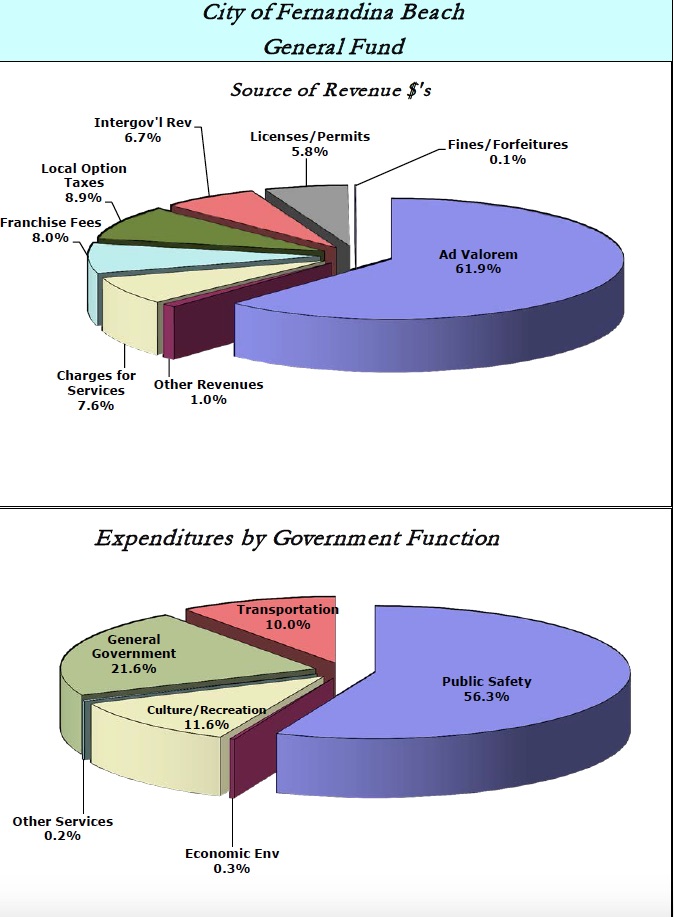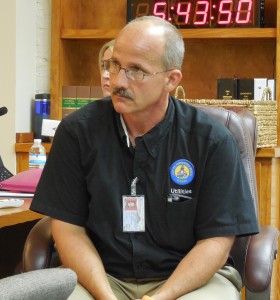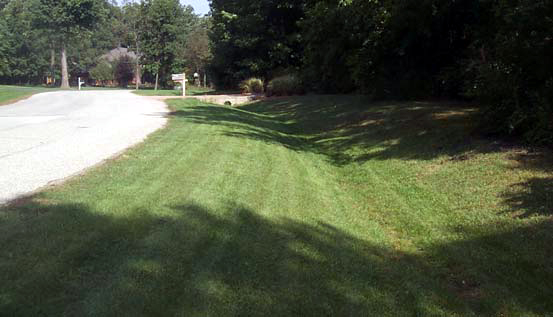Submitted by Suanne Z. Thamm
Reporter – News Analyst
August 21, 2015 4:30 p.m.
The Fernandina Beach City Commission (FBCC) met in workshop session for an hour and a half immediately preceding their Regular Meeting on August 18, 2015. They reviewed and discussed three items:
- Changes to the FY 2015/16 General Fund Budget since July 28, 2015
- The city’s Five-Year Capital Improvement Plan
- Stormwater plans for the North Beach area of the city.
City Comptroller Patti Clifford reported that with the changes last approved by the FBCC, the city continues to meet its 25 percent reserves target: $4.476M.

Utilities Director John Mandrick asked the FBCC to confirm its commitment to building swales to mitigate stormwater flooding in the North Beach area. Mandrick explained how the swales would impact property owners. The FBCC supported the plan.
The first of two mandated public budget hearings will be held on September 3, 2015 at 5:05 p.m. in Commission Chambers; the second and final public hearing will follow on September 22, same place and time.
Changes to the FY 2015/16 General Fund Budget since July 28, 2015
Comptroller Clifford presented the FBCC with a series of General Fund revenues and expenses for the new budget as discussed and approved following review of the original budget proposal in July:
- The addition of $264,268 in revenue from the state
- A $7,500 contribution to the Nassau Economic Development Board (NCEDB)
- Line funding for the Council on Aging – $30,000
- Additional funding to cover Police Department promotion – $5,343
- Social services funding increase – $4,750
- Half-year funding to add a police officer to patrol the Central Business District – $33,500
- Fund transfers:
- $100K from the General Fund to the Capital Improvement Fund to purchase a backhoe
- $60,000 from the General Fund to the Capital Improvement Fund to replace air conditioning units at the Peck Gym.
Clifford asked the commissioners if they wanted to make any additional changes. City Manager Joe Gerrity said, “Speak now or forever hold your peace. After this meeting, the budget goes to press.”


Commissioner Gass asked, “So as it stands now, we will be borrowing $2M?” When Clifford confirmed that, Gass added, “Then put me on the record as saying I don’t want to do that.” Gass cited figures in the Capital Improvements Plan, which reflect that the city would be borrowing $12M over the next 5 years to complete all the named projects.
Clifford also cited some additional changes to the Capital Improvement Budget for FY 2015/16:
- At Vice Mayor Johnny Miller’s suggestion, two new water fountains will be purchased at a total cost of $12,000;
- The airport will pay off a $77,000 loan;
- The marina has budgeted $100,000 to purchase a pump-out boat to service boats in the mooring field. This item was mandated by the increase in the size of the field;
- Additional grant funding for the marina;
- The cost of building swales in the amount of $1M to alleviate North Beach stormwater flooding.
She recapped planned borrowing for the upcoming Fiscal Year:
- $709K for software purchase;
- $800K – Alachua crossing construction;
- $450K – existing debt to be refinanced.
The city’s Five-Year Capital Improvement Plan

Clifford walked commissioners through the 5-Year Capital Improvement Plan, stressing its importance of its adoption to comply with the city’s Comprehensive Plan. While proposed capital expenditures are detailed over a 5-year period along with how they would be financed, the plan is subject to change by actions of future commissions as well as based upon a re-prioritization of projects. Only items that cost $25K or more are included in the plan. Some projects are slated to be funded via grants or impact fees; others from the General Fund and some through loans. For a complete list, consult the city’s website. Items included in the plan for FY 2015-16 include, among others:
- $112,700 to repair pilings under Brett’s Waterway Café
- $400K for a fire truck
- Around a million dollars for computer software and hardware
- $300K for street resurfacing
- $55K to complete window replacement at the Peck Center
- $275K for the Amelia Riverfront Park
- $155K expansion of Egans Creek Park amenities;
- $150K exterior stabilization of historic Post Office building
- $25K train depot platform
- $200K airport welcome center
- $400K Old Town gravity sewer system
The total capital improvement fund currently budgeted for FY 2015/16 stands at $3.46M; the capital expansion fund (impact fee funds) budgeted at $963K.
Stormwater plans for the North Beach area

Utilities Director John Mandrick presented commissioners with a brief slide show to explain what swales were (and were not) and how they would be constructed to mitigate stormwater in the North Beach area. Mandrick said that this project has been budgeted at $20,000 to pay for 20 days of digging swales along North Fletcher Avenue. He said that without borrowing up to a million dollars, this would be the only work that could be covered with existing resources. He asked for direction through the City Manager about the design and appearance of the swales in anticipation of neighborhood outcry over impact on what they have traditionally viewed as their front lawns and parking areas.
Mandrick said that a swale is not a ditch. Rather it is a 1-2 foot deep depression with sides at a maximum 1-foot fall to 4 feet of run. A typical road width is 20 feet, leaving 20 feet on either side for swales. The swale bottom could be 10 feet wide, the width of a parallel parking space. In comparison, a ditch is deep and narrow. Mandrick said that you should be able to drive a car through a swale. He said that while you could park a car in a swale, a heavy rain might flood the car’s floorboard. He cited examples of swales along Interstate 10, which are shallow enough to allow cars to run off the road without damage to the car. Swales give accumulated water from heavy rains time to drain and avoid flooding.

Mandrick presented examples of swales used in various areas of the city, as well as the curb and gutter system used in the Historic District, in order to let commissioners see how stormwater can be diverted. Gerrity asked Mandrick to stay with the plan that had been presented to the Nassau Legislative Delegation in December, which included both pumping water and swales. He said that was the plan that the city would pursue.
Gerrity told the commission’ “People on the North Beach are not going to like the idea of swales. The land has been up there forever. People think the right-of-way is part of their property, and your job as commissioners is going to have to be to withstand the public outcry, because we are going to put swales in. We are going to grass them; they are going to look nice. But they will have a depression.
Mandrick added that it would be tough in some areas because of some of the high salt content in the soil. Getting grass to grow “lush and beautiful” will be a challenge, he said. “That will probably not be reality; it’s not going to happen,” he said. “We can plant the St. Augustine grass there, but within a year or two it’s all going to be dead because of the saltwater spray.”
 Mayor Ed Boner asked if because of blowing sand, the swales would be constantly filling in. Mandrick replied that it would take continual maintenance to keep them open. He said there has not been a lot of maintenance in the area since the city got rid of its grader four years ago. Up until then, the Streets Department would grade the streets regularly to keep sand from piling up.
Mayor Ed Boner asked if because of blowing sand, the swales would be constantly filling in. Mandrick replied that it would take continual maintenance to keep them open. He said there has not been a lot of maintenance in the area since the city got rid of its grader four years ago. Up until then, the Streets Department would grade the streets regularly to keep sand from piling up.
Rex Lester, city Streets Department manager, said that the North Beach area has been dug out three times in the last 15 years. Mandrick said that the city has not been digging out or cleaning areas of sand because of the limited city staff in his department. He said that the city also must budget for people to maintain the system year round.

Mandrick said that as of today the city has yet to completely document its stormwater drainage system. When the city constructed the Broome Street Parking Lot, old drainage lines “packed full of dirt” were discovered. Documenting the system, which was Phase 1 of the stormwater project, was supposed to have been completed in the early 1990’s.
Before the city can begin work on North Fletcher, the city needs to obtain a state permit. Part of the permit process is a requirement to inform the state as to the level of treatment the city plans to give the stormwater before releasing it. “If there is no level of treatment, they are going to be very restrictive as to where you can pump it,” Mandrick said. “You can have all the money in the world, but if you don’t have a permit, you are not going to build anything.”
Mandrick said that before he can design a system for permitting, he needs to know what level of treatment the city intends to provide. Gerrity said, “Swales are the most environmentally friendly way of treating the water.” Mandrick added, “That’s what the state would prefer.” Gerrity continued, “What we need to be concerned with is that the swales we build will be able to handle those monumental rains we get up there.”
Mandrick said that part of the problem is letting the ponds fill without pumping them down. Gerrity said he understood that, but that the first step is getting the swales built.
Boner asked if the city could pump the stormwater into the Fort Clinch ditch. Mandrick replied, “No, because that has not been permitted. It would be an easier sell if we built the swales.” Mandrick said that if the city receives permission to pump water through the park, the cost of a lift station on West 6th Street would be about $250K, and laying pipe would cost about $50 per foot.
Mandrick concluded his presentation saying that he could not give an accurate cost without permits. Depending on what the state will allow, the project could come in much lower than $1M. His purpose in making his presentation was to explain the concept of a swale to commissioners and prepare them for public reaction.
 Miller said that the main concern he had heard from residents of the affected area was whether all properties would be treated the same, or only some properties would have swales. Mandrick replied that both sides of the road would be done at the same time. Miller asked what the city would do about concrete driveways. Mandrick said that past practice has been to replace driveways that were placed in the city’s right-of-way. He added that while people could landscape the swales, they needed to be mindful that these areas would flood with heavy rains.
Miller said that the main concern he had heard from residents of the affected area was whether all properties would be treated the same, or only some properties would have swales. Mandrick replied that both sides of the road would be done at the same time. Miller asked what the city would do about concrete driveways. Mandrick said that past practice has been to replace driveways that were placed in the city’s right-of-way. He added that while people could landscape the swales, they needed to be mindful that these areas would flood with heavy rains.
During public comment, city commission candidate Clinch Kavanaugh informed commissioners that in parts of California the state is paying property owners to remove their grass and replace it with sand or rock as a way to save water. He suggested that a similar policy in Fernandina Beach might cause people to remove grass to improve drainage. Kavanaugh also addressed problems in the CRA area relating to infrastructure and soil subsidence. He also asked the commission to add Wi-Fi connection to their meeting chambers.
 Editor’s Note: Suanne Z. Thamm is a native of Chautauqua County, NY, who moved to Fernandina Beach from Alexandria,VA, in 1994. As a long time city resident and city watcher, she provides interesting insight into the many issues that impact our city. We are grateful for Suanne’s many contributions to the Fernandina Observer.
Editor’s Note: Suanne Z. Thamm is a native of Chautauqua County, NY, who moved to Fernandina Beach from Alexandria,VA, in 1994. As a long time city resident and city watcher, she provides interesting insight into the many issues that impact our city. We are grateful for Suanne’s many contributions to the Fernandina Observer.


